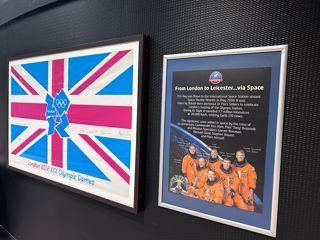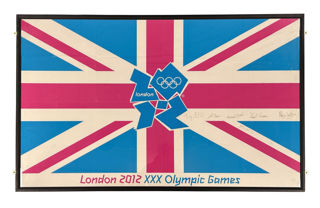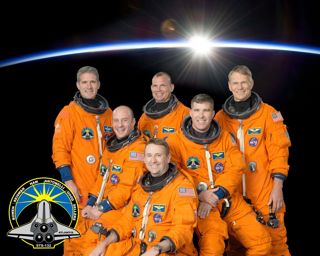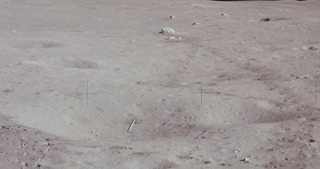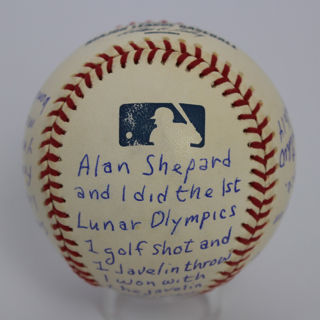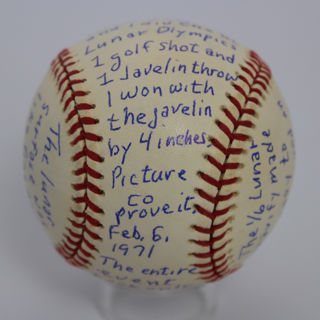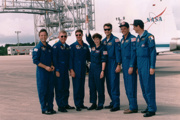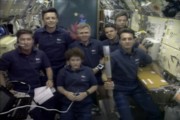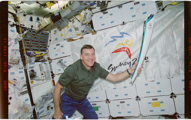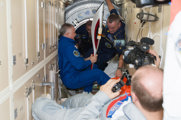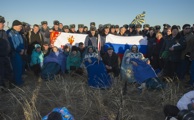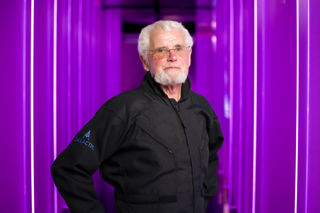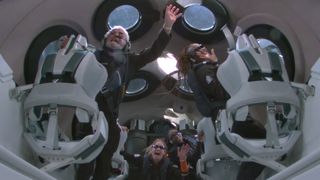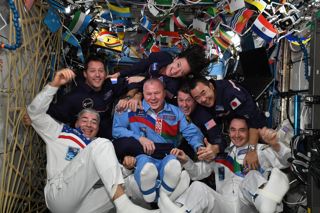
5 Facts about the Olympics and Space
- 22nd Jul 2024
- Author: Emma Mosley
The 2024 Paris Olympics are almost upon us and here at the National Space Centre, we can't wait!
They start soon in a big ceremony on Friday 26 July and finish with a bang on Sunday 11 August. During this time, athletes from across the globe will compete against one another in a variety of different sports, while keeping the Olympic values and ethos alive throughout this jam-packed competition.
To help us get warmed up into the Olympic spirit, we’ve been looking at our favourite 5 facts about the Olympics and space.
The London 2012 Olympic Flag
We have recently put a London 2012 Olympic flag up on display on the outside wall of our planetarium. This flag is very special as in May 2010 British born American astronaut Piers Sellers took the flag with him on his mission to the International Space Station (ISS).
The Space Shuttle Atlantis launched on 14 May 2010 to the ISS with the primary mission to deliver the Mini-Research Module 1. The crew of this mission STS-132 were: Piers Sellers, Kenneth Ham, Dominic Antonelli, Garrett Reisman, Michael Good, and Stephen Bowen. Having brought the flag onboard, Sellers asked his fellow crew to sign the flag.
When the crew returned to Earth, Sellers presented the flag to Lord Sebastian Coe as part of the promotion for the London 2012 Olympics. It then hung proudly on the wall of Lord Coe’s office during the Games. After the 2012 Olympics were finished, the flag was given to the National Space Centre.
The Lunar Olympics
When we think of the Apollo missions to the Moon, we think of the astronauts absolutely focused on achieving their science goals. While they succeeded they also managed to have a little bit of fun and even took part in their own Lunar Olympics!
These Olympics were not a grand affair at all. Only two sports were played when the first Lunar games took place during the Apollo 14 mission in 1971, when astronauts Alan Shepherd and Edgar Mitchell were on their final lunar excursion.
It turns out Shepherd loves golf, so much so he even brought a six iron and two golf balls with him! His first attempt at hitting the golf ball missed, with his second just catching the ball. His third attempt sent the ball about 22 metres away with Shepherd claiming it was miles and miles. You can see his golfing skills in action in this video. Mitchell, not wanting to be outdone, picked up the leftover pole from the Solar Wind Composition Experiment and threw it like a javelin. It landed in the same crater as the golf ball and Mitchell claims to have won as the javelin was ten centimetres ahead. Though Shepherd’s second golf ball landed about 36 meters away! This crater is now named Javelin Crater, home to the javelin and a golf ball.
The second Lunar Olympics took place a year later, in 1972, during the Apollo 16 mission. It was a few months before the 1972 Olympics started, which were being held in Munich, Germany. For Apollo 16, there were plans to have their own Descartes Olympics in tribute to the Games in Munich.
Unfortunately they ran out of time so the two astronauts, Charles Duke and John Young, improvised. They managed to do a few high jumps, with Young completing five and reaching a height of roughly 70cm. Duke attempted a high jump reaching about 82cm but then fell backwards onto his backpack. Thankfully he didn't injure himself or damage his suit, as a suit failure would have been critical. He mentioned in later interviews that this was the only point during his mission where he felt like his life was in danger.
Afterwards they continued collecting equipment and samples when Duke grabbed the pole from Apollo 16’s Solar Wind Collection Experiment. Then, like Mitchell before him, he threw it as a javelin which some think landed about 20 metres away. I don’t know exactly who threw the javelin the furthest but it's looking like Edgar Mitchell for the gold!
Here at the National Space Centre, we have a very special artefact, an official Major League Baseball. This baseball has been written on by Apollo 14 astronaut Edgar Mitchell, recounting his story of the Lunar Olympics and him winning! You can see this is in our Space Oddities section within our Galleries during this year's Olympics.
Olympics in Space?!
The ISS orbits above Earth at 400 km. It may not seem a large distance but it is far enough that it seems like there is no gravity when compared to down here on Earth. This makes the astronauts feel as if they are weightless, with them and the objects around them floating about. To move around they propel themselves with their hands and feet, they also use their feet to hook onto poles whilst they are working so they don't float off. They even have to strap themselves in when sleeping. Now that takes sleep walking to a whole new level!
This makes taking part in exercise very difficult and the astronauts could end up like a pinball bouncing around inside the ISS if they didn’t strap themselves down when on the treadmill. Though this hasn’t stopped the astronauts from having a go themselves whenever the Olympics were on!
In 2010, during the Winter Olympics in Vancouver, the crew took part in their own events such as space skiing and weightless figure skating. Japanese astronaut Soichi Noguchi even took his own small skis!
In 2021 the crew held their own Space Olympics by splitting into two teams and competing in a range of events. Team Crew Dragon and Team Soyuz faced one another in: lack-of-floor routine, no handball, synchronised space swimming and weightless sharpshooting. I'm not sure who won the gold though...
An out of this world Olympic Torch Relay
Before an Olympic Games can officially start, the Olympic cauldron must be lit by the Olympic flame during the Opening Ceremony. Weeks or even months before the Games start, the Olympic flame is ignited using sunlight during a ceremony in Olympia, Greece. The first torch in the Olympic torch relay is lit using this flame and then undergoes a global journey to reach the host country and the Olympic cauldron.
The flame is passed on torch to torch across its global journey. Over the years it has even been on an out of this world trip three times. The torch was usually an unlit spare and was taken up in 1996, 2000, and 2014. It was first flown to space by the Space Shuttle Columbia in 1996 for the Olympics in Atlanta, USA. Australian born NASA astronaut Andy Thomas brought the Olympic Torch and the Olympic flag onboard his mission on the Space Shuttle Atlantis for the Sydney Olympics in 2000. For the Sochi Winter Olympics in 2014, it was taken up to the ISS on board a Soyuz. During its few days stay, two cosmonauts Oleg Kotov and Sergei Ryazansky took the torch on a spacewalk! You can watch this here.
Did you know the Olympic torch had another out of this world visit, here at the National Space Centre in 2012?! You can see what we all got up with Darth Vader, Gary Lineker, Jet Pack man, and all our visitors here.
Olympians in Space
Olympians and astronauts have a lot in common, from pushing themselves physically and mentally, to working with the global community. Some astronauts have even trained for the Olympics before having a career in space. Though it took until 10 August 2023 to send an Olympian into space!
British slalom canoeist Jon Goodwin purchased a ticket for a flight on board a Virgin Galactic flight in 2005. In 2014 he was diagnosed with Parkinson’s disease but, thankfully, was declared fit for his flight. He has not let his Parkinson's stop him from doing things he wants to do. In doing so he has managed to inspire and prove to everyone that having Parkinson's doesn't mean you can't do things out of the ordinary.
Flying onboard the VSS Unity from Spaceport America in New Mexico, the 'Galactic 02' mission was a success. With the crew on board able to move around by floating and getting a spectacular view of Earth. This now makes Jon the first Olympian to go to space as well as the second person with Parkinson’s, and the oldest Brit at 80 years young!
What do you think to our favourite 5 facts about the Olympics? Now that we are thoroughly warmed up and ready for Games to start...
GO TEAM GB!
Full references/credits:
(Banner) A picture of astronauts onboard the ISS celebrating the Tokyo 2020 Olympics. Credit: ESA/NASA-T. Pesquet
(1a) A picture of the crew of the mission STS 132. Credit: NASA
(1b) The 2012 Olympic Flag on the outside wall of the Planetarium. Credit: National Space Centre
(1c) An image of the 2012 Olympic Flag. Credit: National Space Centre
(2a) A video of Edgar Mitchell’s javelin throw. Credit: NASA
(2b) An image of the Javelin Crater on the Moon. Credit: NASA
(2c) An image of the baseball from the front. Credit: National Space Centre
(2d) An image of the baseball from the bottom. Credit: National Space Centre
(3a) A video of the 2010 Astronaut Olympics. Credit: NASA
(3b) A video of the 2021 Space Olympics. Credit: ESA/NASA
(4a) A picture of the crew of the mission STS 78 with the Atlanta Olympic torch in 1996. Credit: NASA
(4b) A picture of the crew of the mission STS 78 with the Atlanta Olympic Torch onboard the Space Shuttle Columbia. Credit: NASA
(4c) The 2000 Olympic Torch held by Australian born NASA astronaut Andy Thomas who got a replica to take onboard the Space Shuttle Atlantis. Credit: NASA
(4d) Astronaut Jim Voss is holding a replica of the 2000 Olympic Torch onboard the Space Shuttle Atlantis. Credit: NASA
(4e) The Olympic Torch for the 2014 Winter Olympics arrives onboard the ISS. Credit: NASA
(4f) The cosmonauts return after their mission to the ISS where they collected the Olympic Torch from the new ISS crew. Credit: NASA
(5a) A portrait of the Olympian astronaut Jon Goodwin. Credit: Virgin Galactic
(5b) A picture of the crew of Galactic 02 in mid flight leaving their seats. Credit: Virgin Galactic

